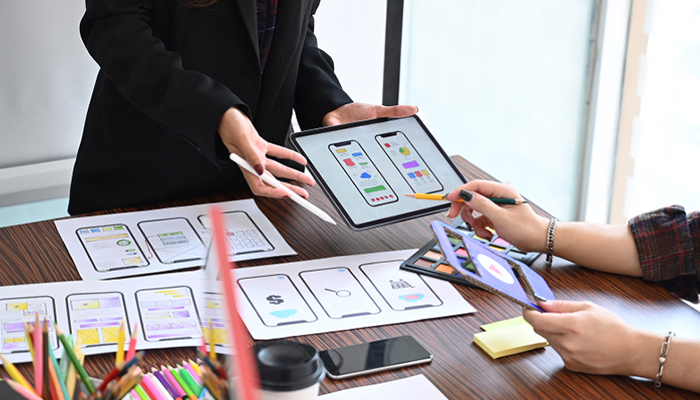Creating a functional mobile app within a tight timeline can be challenging, but refining its design doesn’t have to mean cutting corners. With the right direction and efficient collaboration, even a four-week sprint can yield polished, user-friendly results. For businesses working with mobile app design services or in-house teams, these steps can keep the process sharp, intentional and on track.
Here’s how to streamline your app’s design within a month, without sacrificing quality or usability.
1. Start With a Clear Design Audit
Before sketching or prototyping anything new, conduct a focused design audit. Identify friction points, unclear navigation, and any areas where users tend to drop off. This lays the groundwork for meaningful improvements. Mobile app design services often start here to ensure updates are based on actual issues, not assumptions. Whether it’s legacy apps or first iterations, this step brings clarity to what needs attention within your timeframe.
2. Refine Your User Personas and Use Cases
In a rush, teams can easily default to broad user assumptions. But a brief check-in with your actual audience can reset priorities. Gather updated feedback and reassess how your app serves its intended purpose. Even a few well-timed user interviews can highlight overlooked needs or preferences. Revisit your user journeys with fresh eyes to ensure design choices directly support user behaviour.
3. Simplify Navigation Patterns
A cluttered app interface wastes time and frustrates users. In the first week, focus on reducing layers of navigation, consolidating menus, and making key actions more intuitive. Minimal effort here can dramatically enhance usability. Look at your most-used features and place them where they’re accessible in just one or two taps. Don’t overcomplicate with advanced UI elements if simple tabs or buttons get the job done faster.
4. Draw from Strong Mobile Web App Design Inspiration
There’s value in studying well-designed mobile web apps, not to copy them, but to understand what design patterns work across devices and industries. Take note of how other apps handle onboarding, transitions, and responsive elements. Many design solutions emerge not from invention, but from subtle adaptation. By the second week, drawing inspiration from these interfaces can speed up decision-making and refine your own direction.
5. Align With a Design Agency in Singapore If Needed
When internal teams hit a creative wall or need to accelerate timelines, involving a design agency in Singapore can make a difference. Agencies bring fresh eyes, process frameworks and expertise in fast-turnaround design projects. A short-term collaboration, even over a few weeks, can introduce efficiencies your current workflow lacks. They can also guide you through issues like accessibility compliance or device compatibility without adding delays.
6. Focus Visual Hierarchy on Clarity, Not Flashiness
Instead of adding more icons, gradients, or shadows, trim unnecessary layers that distract from key content. A strong visual hierarchy relies on spacing, scale and colour contrast. Consistency also plays a large role here. Ensure that text styles, button placements, and image usage follow a defined system. Design decisions made during crunch time must be easy to maintain later, so lean into clear logic over visual flair.
7. Test with a Realistic Prototype
Before locking in design changes, create a functional prototype that represents the latest structure and flow. Let testers explore the design freely, this reveals how they actually move through your app, rather than how you expect them to. Use tools that mirror device behaviour closely so you don’t misread feedback. Feedback loops should be tight and focused during this stage, ideally with quick revisions each day.
8. Rework Microinteractions and Feedback Cues
Small interactions like button presses, swipe animations, loading indicators, make a major difference in perceived smoothness. Even if your time is limited, refining these moments boosts confidence and trust in the app. Spend part of the third week cleaning up transition states, ensuring every action feels intentional. You don’t need to reinvent anything, just polish what’s already there.
9. Lock in a Scalable Design System
The final week should focus on solidifying a design system. This doesn’t need to be exhaustive but it must ensure consistency. Define colour palettes, component styles, and spacing rules that will serve your app through updates. Even simple documentation helps reduce future confusion and gives developers a clear reference. Treat it as a foundation, not a one-time task, and evolve it as your app grows.
10. Wrap Up with Focused Handoff Sessions
Design only works when it’s executed well. Once design files are final, hold handoff sessions with developers that prioritise clarity and alignment. Walk through intended behaviours, interactions, and edge cases. Clean, labelled files go a long way, but face-to-face (or screen-to-screen) handovers ensure everyone understands the rationale behind each change. Keep communication open to prevent late-stage surprises.
A month may not feel like long, but it’s enough to deliver meaningful design improvements, provided the effort stays focused. Streamlining your workflow, drawing on mobile web app design inspiration and working with the right team can help keep your project moving at pace.
Contact Right On Media to learn how expert mobile app design services can support your next project in Singapore, from concept to launch.

